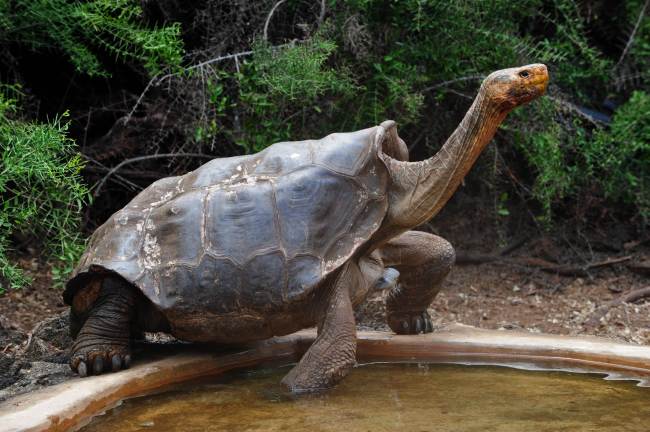Effort to revive Galapagos tortoises once thought extinct
By Korea HeraldPublished : June 20, 2013 - 20:27
PUERTO AYORA, Ecuador (AFP) ― Scientists will try to revive two species of giant Galapagos tortoises thought to have been extinct by breeding genetic relatives in captivity, experts leading the effort said.
The Galapagos Islands, located 1,000 kilometers off Ecuador’s Pacific coast, are famed for the large number of species that have developed there in isolation.
New research techniques have revealed that at Wolf volcano on Isabela Island, 17 hybrid giant tortoises have been found with genes from the extinct Pinta Island tortoise, and about 280 hybrids have been found with genes from the extinct Floreana Island tortoise.
The Galapagos Islands, located 1,000 kilometers off Ecuador’s Pacific coast, are famed for the large number of species that have developed there in isolation.
New research techniques have revealed that at Wolf volcano on Isabela Island, 17 hybrid giant tortoises have been found with genes from the extinct Pinta Island tortoise, and about 280 hybrids have been found with genes from the extinct Floreana Island tortoise.

Among those with Pinta genes, at least one pair has 80 percent of the original species’ genes, while among the Floreana hybrids, many have up to 90 percent of the original species genes.
“That gives us the possibility, literally, of bringing back these species which at the moment are considered extinct,” Galapagos National Park applied sciences chief Washington Tapia told AFP.
Giant tortoises have life spans of up to 180 years, growing to 1.8 meters long and nearly 400 kilograms in weight.
Last year the body of “Lonesome George,” a giant Galapagos tortoise once believed to be the last of its kind, was sent to New York after its death to be embalmed and then returned home.
A rare Pinta Island giant tortoise discovered in 1971, George was estimated to be a century old when he died June 24, 2012. At the time, he was believed to be the last of his kind.
The Floreana Island tortoise was widely thought to have been extinct for more than 100 years. One of their last sightings was by British naturalist Charles Darwin when he visited the Galapagos in 1835.
Darwin studied the tortoises, which evolved in isolation, as he developed his theory of natural selection.
Now Tapia’s team is eyeing something of reverse natural selection: bringing back to life animals technically considered to have died out.
He said that experts will soon start trying to get pairs in captivity to produce offspring close to their genetic origin. But due to the lengthy lifespan of the animals, Tapia said that he will not live to see the results:
true to the slow pace tortoises are famous for, it should take about 120 years to get all the data in.
The female tortoises reach sexual maturity at around 20-25 years, and males at around 25-30. Tapia said that mating a female and male with 80-90 percent Floreana genes should produce offspring with about 95 percent of the genes of the original species.
With the Pintas, “there is a chance, albeit remote, that we could end up with a male being produced with only original-species genes,” Tapia said.
For now, the future of the Floreana lies with about 92 animals born in captivity since 2012. More testing has to be done to determine which have the greatest original-species genetic content so that those males and females can be bred.
Tapia said that one of the main goals is for the tortoises to be released back into their natural habitats as soon as possible, even as hybrids, so that they can help bring the ecosystems of the islands back into balance after they were disturbed by imported species, such as goats.
The Wolf hybrids have a salty story of their own: park officials believe the tortoises were taken to Isabela Island in the 17th and 18th century by pirates who picked them up to eat, but then decided they were no longer needed as a source of meat and tossed them overboard.
-
Articles by Korea Herald








![[Today’s K-pop] BTS pop-up event to come to Seoul](http://res.heraldm.com/phpwas/restmb_idxmake.php?idx=644&simg=/content/image/2024/04/17/20240417050734_0.jpg&u=)
![[Graphic News] More Koreans say they plan long-distance trips this year](http://res.heraldm.com/phpwas/restmb_idxmake.php?idx=644&simg=/content/image/2024/04/17/20240417050828_0.gif&u=)
![[KH Explains] Hyundai's full hybrid edge to pay off amid slow transition to pure EVs](http://res.heraldm.com/phpwas/restmb_idxmake.php?idx=644&simg=/content/image/2024/04/18/20240418050645_0.jpg&u=20240419100350)






![[KH Explains] Hyundai's full hybrid edge to pay off amid slow transition to pure EVs](http://res.heraldm.com/phpwas/restmb_idxmake.php?idx=652&simg=/content/image/2024/04/18/20240418050645_0.jpg&u=20240419100350)

